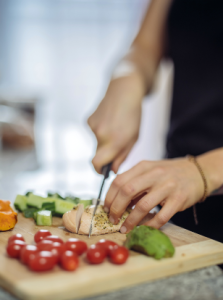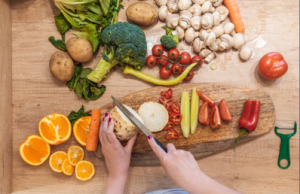When life gets busy, preparing meals can sometimes fall to the wayside. Whether you are juggling work, caregiving, or other responsibilities, meal planning can be a lifesaver! Let’s dive into some simple steps to help you plan your meals that fit your busy schedule!
Article is available in ASL, scroll down to see video at the bottom of the page.
What is Meal Prepping?
Meal prep or meal planning involves preparing entire meals or individual components in advance to make feeding yourself easier throughout the week. The great thing about meal prep is that it can be as involved as you would like it to be. It can be as simple as rinsing and chopping fruits and veggies or as involved as cooking most of your lunches for the week. It’s a personalized process and it will look different for everyone.
Benefits of meal prepping:
- Save time
- Save money
- Support healthier eating habits
- Reduce stress
- Reduce food waste
Start Simple
If you are new to meal prep, it’s natural to feel a bit overwhelmed in the kitchen, especially if you try to do too much at once. Therefore, my #1 tip is to start small – begin with just one meal such as prepping your breakfasts or batch prep only one main ingredient for the week. Once you get comfortable with that, you can gradually expand to include other meals or batch prep more ingredients. Starting small helps you build confidence and establish a routine without feeling overwhelmed.
Three Different Ways to Meal Prep:
- Make-Ahead Meals: This involves cooking entire meals in advance so they’re ready to eat when you need them. They are stored in the fridge and need to be reheated at time of consumption. These meals are typically prepared in bulk over the weekend or on a day when you have more tie. This method is great for those who prefer to have their meals fully prepared and ready to go, saving time on busy days. Examples include casseroles, soups, lasagnas that can be baked and portioned for the week.

- Assemble-Ahead Meals: This involves prepping and organizing ingredients ahead of time, but not fully cooking the meal until its ready to be eaten. This method is about doing the prep work such as chopping vegetables, marinating proteins, measuring out grains so that when it comes time to cook, everything is already prepped and ready. This approach allows for a quicker meal assembly on busy nights, and it gives you the flexibility to cook fresh meals with minimal effort. For example, one day you might prepare all the components for a stir fry and store in the fridge so all you have to do is toss them in a pan when you’re ready to eat.
- Batch Prep: Batch prep involves cooking large quantities of specific ingredients that can be used in various meals throughout the week. Instead of preparing full meals, you focus on cooking components like grains, proteins or roasted vegetables in bulk. These pre-cooked ingredients can then be mixed and matched to create different meals. For example, you might roast a large batch of vegetables, cook a pot of quinoa, and grill chicken breasts, which can be used in salads, wraps or grain bowls throughout the week. This is idea for individuals who like variety in their meals but want to minimize cooking time on busy days.
How to Start Meal Prepping
It’s as Easy as 1, 2, 3! Follow these steps to start your meal prepping journey:
Step 1: Plan your meals
A good place to start is sticking to recipes you are familiar with. Check out Pinterest, cookbooks and family recipes to get inspiration! Overtime you will build up your go-to pantry staples to the point where you can plan meals without needing to rely on recipes.
Step 2: Grocery shopping
This is one of the most important steps because it ensures that you have all the ingredients you need to prepare the planned meals. I always suggest checking what you already have in the pantry first, then add what you will need for the meal to your list. Write your grocery list and have it prepared for your trip to the store. As you experiment with different recipes, you’ll begin to notice which ingredients you enjoy the most and use most frequently. These will become your go-to pantry staples. As you identify your favorite ingredients, you can start stocking up on them during your regular grocery trips. This helps you build a well-rounded pantry overtime without overwhelming yourself or your budget.
Step 3: Pick your Prep
It’s now time to prep! Pick a meal prep style that works best for you and your lifestyle. Remember to make this a joyous experience, throw on your favorite playlist, listen to a podcast, or cook with a friend or family member!
Happy cooking!
Cassandra RDN
Medical Advice Disclaimer: The information provided on this blog is for informational and educational purposes only. No material provided in this blog, including images and graphics, is intended as a substitute for professional medical advice, diagnosis, or treatment. Always seek the advice of your physician or other qualified health care provider before making any dietary changes or starting a new health care regimen. Do not neglect professional advice because of what you may have read in this blog.
Access This Article in ASL:



